Creation Creativity
Monday 4 October is the Feast Day of St Francis of Assisi. Many paintings and statues depict him with all kinds of animals, birds and trees. Francis recognised that all of creation is interconnected with one another and with God, who is present in each and every single thing that is living.
I invite you to read and ponder his beautiful words:
“Be praised, my Lord, through all your creatures, especially through my lord Brother Sun, who brings the day; and you give light through him. …Be praised, my Lord, through Sister Moon and the stars; in the heavens you have made them, precious and beautiful.”
 Last month, along with many churches across the world, we marked the Season of Creation. And along with two of our Partnership Churches: Stainbeck and Christ Church, we drew on our creativity. As Julia Cameron has written: “Creativity is God’s gift to us. Using our creativity is our gift back to God.” And so, we embarked on a craftivism project. Craftivism is for anyone who wants to make beautiful and useful craft with a message — helping us and others to stop and reflect. Our aim in making and displaying flowers on our street-side windows was to draw attention to the beauty and diversity of our world. We also hoped to highlight that being part of God’s Creation means we need to pray and act with care and love. Let us continue to do so, so that every part of Creation may flourish and thrive.
Last month, along with many churches across the world, we marked the Season of Creation. And along with two of our Partnership Churches: Stainbeck and Christ Church, we drew on our creativity. As Julia Cameron has written: “Creativity is God’s gift to us. Using our creativity is our gift back to God.” And so, we embarked on a craftivism project. Craftivism is for anyone who wants to make beautiful and useful craft with a message — helping us and others to stop and reflect. Our aim in making and displaying flowers on our street-side windows was to draw attention to the beauty and diversity of our world. We also hoped to highlight that being part of God’s Creation means we need to pray and act with care and love. Let us continue to do so, so that every part of Creation may flourish and thrive.
Nicola
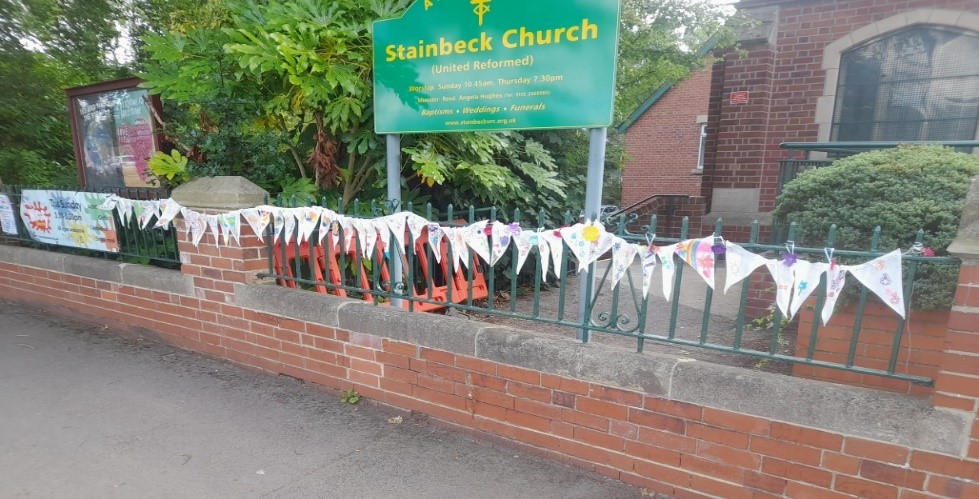
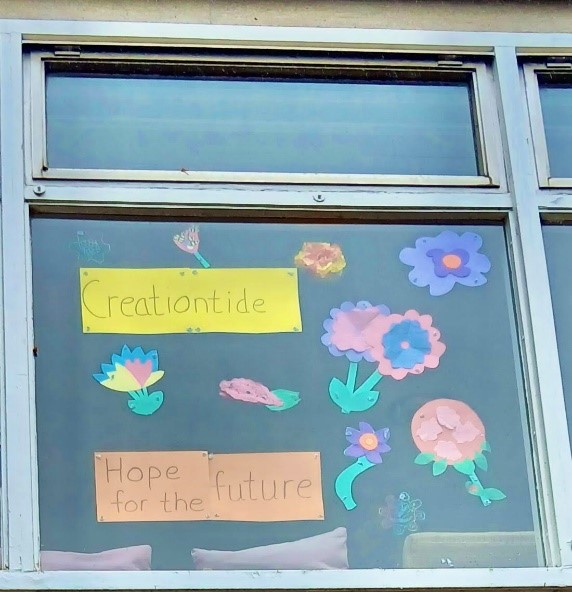
| CALENDAR | |||
| OCTOBER | |||
| 6th | SUNDAY | 10.45am | Morning Worship led by Rev Phil Chilvers |
| 8th | Tuesday | 12.30pm | Guild Lunch |
| 13th | SUNDAY | 10.45am | Morning Worship, led by our Minister, Rev Dr Nicola Robinson, including the Sacrament of Holy Communion |
| 12 noon | CHURCH MEETING | ||
| 20th | SUNDAY | 10.45am | Morning Worship led by Rev Phil Chilvers |
| 27th | SUNDAY | 10.30am | Morning Worship at West Park URC, led by Rev Angela Hughes |
| NOVEMBER | |||
| 3rd | SUNDAY | 10.45am | Morning Worship led by Rev Phil Chilvers We shall be joined by our friends from Headingley Methodist Church |
CHURCH CHARITIES
Retired Ministers Housing Society, Caring for Life, Wheatfields, Leeds Samaritans, Bible Society.
There are now only a few new items left to put out onto the Charity sales table so I am asking if anyone has anything they are willing to donate to help us to raise money for the five charities we support. The Book Stall always needs replenishment as well.
Please consider helping us in this way. Thank you.
Margaret Madill
THANK YOU
A big ‘Thank you’ to Susan Bollon for organizing the Family Barbecue following our Harvest Festival and Book Sunday. Sadly, someone made a less successful job of the weather this year and we were forced to ‘picnic’ in the Large Hall; but a good time was had by all.
Another big thank you to David and Richard who faced the elements outside and expertly cooked the chicken, sausages and hamburgers for us. And thanks to everyone who lent a hand with serving, clearing up, washing up and helping others.
GUILD LUNCH
With the first of the month falling on a Tuesday, our lunch seems quite early – so do put a note in your diary for Tuesday, 8th October. We shall meet as usual at about 12.30pm for lunch at 1 o’clock. We look forward to seeing you and if you haven’t joined us before, do think about it if you have a free day. The cost is £4 and to help with catering just let Elissa, Rosemary or Margaret know.
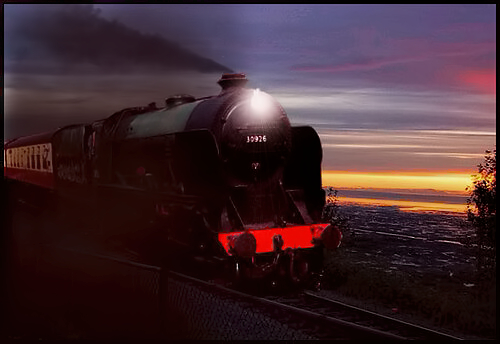
“CHILDHOOD VISITS TO DUNDEE”
My Scottish roots remain especially important to me. My father was born in Dundee and my mother was raised in the church manse in Dunnichen, Angus. Soon after being married my father’s work took them South into England and they spent time in Tynemouth and Southport before settling in Newbury in Berkshire where I and my two brothers, spent the majority of our childhood.
My fondness for Scotland and Dundee in particular stems from the fact that every family holiday during my formative years was spent visiting family and friends of my parents in and around Dundee. We stayed with my paternal Grandmother and my father’s Aunt.
We would travel by train, first to Paddington and then across London to King’s Cross where we would take the overnight sleeper. To a young child this was an exciting adventure and I can so clearly remember the steam, the smell of diesel and the sight of porters pushing luggage trolleys. Once on board it was straight to bed for me and my brothers. I remember that my mother had read an article which stated that British Rail washed the blankets in first class once every three years which was better than those in second class which never saw the inside of a washing machine! For this reason, we were strongly encouraged to keep our faces far away from the blankets, always thankful that there was a barrier of crisp, cotton sheeting between us and the tainted top layer. As you can imagine we got very little sleep and, at around 5am, we received a visit from the train steward, a little North of Edinburgh with cups of sweet tea and digestive biscuits. This was the signal to get dressed and I remember my father warning us not to lean too far out of the window for fear of being decapitated.
Our paternal Grandmother and Great Aunt would always welcome us by waving a tablecloth outside the bay widow of their second floor flat as our sleeper rode the bend of the splendid Dundee rail bridge. It was always a relief to make it safely across the bridge unlike the unfortunate passengers in December 1879 immortalised in verse by William McGonagall. The hilly city with its familiar sandstone houses and church steeples lay in front of us as did the joy of being on holiday with carefree days ahead. Of course, there were often family visits to make when we would have to be on our best behaviour when we would much rather have played outside. However, any boredom felt was at least partly mitigated by the promise of scones and cake (Dundee of course).
Kate
When I spoke to Kate about having asked Sandra Barry to contribute an article about her experiences in France she kindly and immediately(!) offered to write something herself. She did not reveal the subject so ‘Thank you so much, Kate’ for a wonderful article that brings back the excitement of childhood holidays so vividly. If you, too, have a story, anecdote or experience to share do let me know. It will be greatly appreciated by us all.
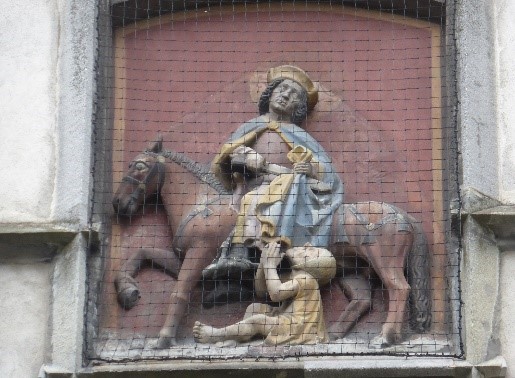 While on holiday we seemed to keep coming across churches dedicated to St Martin. The picture opposite is of a relief set high in the wall of the medieval church in Chur, Switzerland’s oldest town. Originally consecrated in 769 AD, the church was rebuilt in by 1491 following the great fire of 1464 and became the centre of the Reformation in Chur in 1523. The church, along with the Cathedral further up the hill, dominate the old, medieval part of the town.
While on holiday we seemed to keep coming across churches dedicated to St Martin. The picture opposite is of a relief set high in the wall of the medieval church in Chur, Switzerland’s oldest town. Originally consecrated in 769 AD, the church was rebuilt in by 1491 following the great fire of 1464 and became the centre of the Reformation in Chur in 1523. The church, along with the Cathedral further up the hill, dominate the old, medieval part of the town.
In Leeds, we have several churches dedicated to St Martin, bur, by far the most famous is ‘St Martin in the Fields’ in the heart of London in Trafalgar Square. And the story of St Martin still inspires its work each day.
Perhaps you remember his story from your childhood. Originally from what is now Hungary, Martin – born in 316AD -followed his father into the Roman army where, his father hoped, his interest in Christianity would be quashed. While serving as a cavalryman in France during a bitter winter, Martin noticed a helpless, miserable beggar at the roadside. With no other means of helping him, he cut his military cloak in two, giving half to the beggar. That night Christ appeared to him in a dream, wearing the half-cloak. This strengthened his faith and he was baptized, convincing him to leave the army, which he eventually succeeded in doing.
He studied, preached and evangelized and was always aware of the needs of the poor and sick and his holiness attracted others to serve as he did. He was so loved and respected by the people that, in 371, he was consecrated as Bishop of Tours. He had no desire to hold this position and he was tricked into it – but that is another story. He was a ‘serving’ Bishop, continuing to live a life of humility rather comfort.
His Saint’s Day – 11th November – is still widely celebrated on the continent, traditionally with a meal of goose.
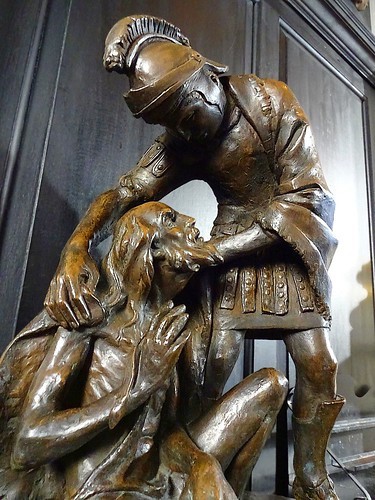 The statue on the right is from St Martin’s in the Fields. The church is famous for its music and its outreach into the wider community, particularly working with the young and homeless.
The statue on the right is from St Martin’s in the Fields. The church is famous for its music and its outreach into the wider community, particularly working with the young and homeless.
Revd Dick Sheppard was vicar from 1914 – 1927. On the onset of war he spent several months as a chaplain to a military hospital in France where he witnessed some horrific incidents resulting in a breakdown. This brought his return to St Martin’s. He determined to make this ‘fashionable’ church a place of safety, taking inspiration from the story of St Martin and his cloak – spreading a cloak over those who had fallen down– ‘The Church with the ever open door’.

